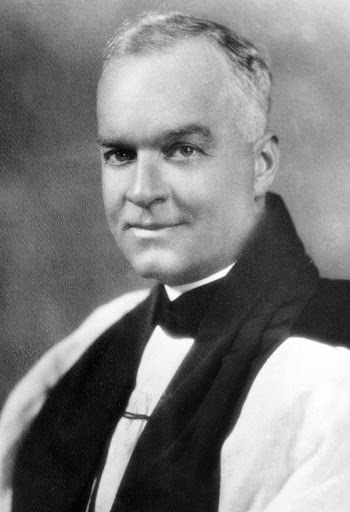Fifth Bishop of Georgia, 1935-1954
(September 9, 1882-May 6, 1957)
 Middleton S. Barnwell was born September 9, 1882 in Louisville, Kentucky. The son of the Rev. Stephen Elliott Barnwell and Elizabeth Cleland, his father was for many years the rector of St. John’s in Louisville. His father was also the nephew of Georgia’s first bishop, the Rt. Rev. Stephen Elliott, Jr.
Middleton S. Barnwell was born September 9, 1882 in Louisville, Kentucky. The son of the Rev. Stephen Elliott Barnwell and Elizabeth Cleland, his father was for many years the rector of St. John’s in Louisville. His father was also the nephew of Georgia’s first bishop, the Rt. Rev. Stephen Elliott, Jr.
Barnwell was graduated from Center College in Danville, Kentucky, with an associates degree. He worked in business for four years before responding to a call to the priesthood. He earned his Bachelors in Divinity from the Virginia Theological Seminary, who later was granted an honorary doctorate. Barnwell first served in Shelbyville, KY, before becoming the assistant rector at Christ Church in Baltimore in 1909. In 1911, he become rector of St. Andrew’s Church in New Bedford, Massachusetts. While serving St. Andrews, Barnwell married Margaret Thorne Lighthall (1889-1960).
He worked at the Church of the Advent in Birmingham, Alabama, from 1913-1923. Barnwell then became field secretary to the Protestant Episcopal Church and then was consecrated Bishop of Idaho in 1925. During this time in the late 1920s and early 30s, Barnwell ran St. Margaret’s School, a secondary girls academy in Boise, Idaho. With the Depression, more girls began to attend public school. Bishop Barnwell advocated that the academy become a junior college so that local high school graduates could begin their college education without out-of-state costs. In February, 1932, he began working to form a junior college out of St. Margaret’s. While he found no local support, Barnwell did secure funding from The Episcopal Church. September 6, 1932, Boise Junior College opened its doors to about 75 students and fourteen faculty members (eight of whom were full-time). Bishop Barnwell served as the college’s president from 1932 until 1934. At that time he recommended that Boise Junior College become a public institution. That junior college grew to become Boise State University. During those same years, he founded the Idaho Summer Camp on Payette Lake and built St. Luke’s Hospital.
Barnwell reflected on the work of a bishop in his 1953 address to convention with some humorous remarks on the toll of weekends on the road, before saying, “I should say, after studying it for twenty-eight years, that being a bishop does not require the highest grade of mentality. Nor does it require pulpit eloquence. In the long run, this is a distinct drawback. Dioceses are built up by slow, steady, plodding and patient work, and there are no exceptions to this rule.”
Barnwell had served in as Missionary Bishop of Idaho for nearly a decade when the call for a bishop coadjutor went out from the Diocese of Georgia. At the time of his 1935 election as Bishop of Georgia, there were 16 parishes, 21 organized missions, 13 unorganized missions, five mission stations and one parochial mission. The still segregated church records noted 5,391 white and 1,029 black communicants. During his tenure as bishop, which lasted until 1954 the Diocese grew to 8,156 total communicants with two more churches becoming parishes and four additional missions created.
He died in Savannah on May 6, 1957. Bishop Barnwell and his wife Maggie had no children. She died in 1960. The couple is buried at Savannah’s Bonaventure cemetery.
He was succeeded by Albert Rhett Stuart as Bishop of Georgia.
